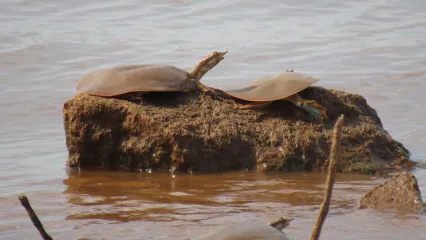
Description
Forty-six species of snakes are native to Oklahoma. Of those, seven species are venomous. And the copperhead is one of those venomous species. They are found in the eastern and central portions of Oklahoma and are important in controlling the population rodents and vermin.
The copperhead is a pit viper, meaning it has heat-sensory pits between each eye and nostril that helps it to detect heat sources which helps it to hunt. It is a medium-size snake with a wide body and a broad head. They have a distinctive neck and get their name from their copper-red heads. They are light brown or tan in color with dark bands, which are in the shape of an hourglass, going around their body.
They are carnivorous and eat mostly rodents, but they also will eat insects or frogs. They are considered to be mobile ambush predators, meaning they mostly catch their prey by waiting for unsuspecting prey to move by. Then they will strike their victim. If the prey is larger, the copperhead will allow it move off and die from the venom then track it down and devour it later. If the prey is smaller, the snake will usually hold onto it and wait for it to die. At times, copperheads have been known to actively hunt for food. But they usually eat only 10-12 meals per year depending on the size of the prey.
The venom of the copperhead is considered mild and is rarely fatal to people if medical treatment is sought immediately. These snakes are generally not dangerous unless cornered or threatened, and they prefer to escape without incident. Most bites occur because the copperhead will usually stay still when it senses danger, and most people will walk right up to them without noticing them because of their extremely effective camouflage. The best strategy for a copperhead encounter is to simply leave it alone. When a copperhead bites a person, it typically won’t inject much venom because it is meant to be only a warning to scare away the perceived threat.
One interesting fact about the copperhead is that a protein called contortrostatin, found in its venom, has been found to inhibit the growth of cancer cells and is being studied for use in human medicine. Another fact: When touched or threatened, the copperhead will sometimes emit a musk that smells like cucumbers.
Size
An adult copperhead will usually grow to a length of 2 to 3 feet.
Life Cycle
Copperheads are mostly nocturnal during summer but are usually active during daylight in spring and fall. The mating season lasts from February to May and late August to October. Females usually give birth to four to seven young, but there have been litters of up to 20 observed. Copperheads are ovoviviparous, which means that the eggs will incubate and hatch inside the female’s body and the offspring will be born alive.


